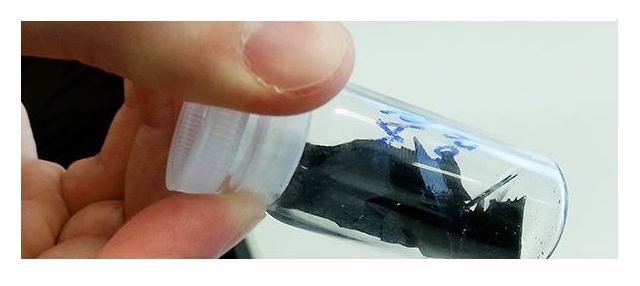
These new materials could almost double the capacity of lithium-ion batteries. Vanadate borate glass.
Image credit: ETH Zürich / Peter Rüegg
Materials scientists and chemists from ETH Zurich have designed a glass material that can be used in lithium-ion batteries as an electrode material - this is expected to greatly improve the energy density and capacity of the batteries.
According to energy experts, more clean energy will be required in the next few years to substitute for dwindling fossil fuel sources as well as to minimize carbon dioxide emissions. An example being that we will need batteries capable of lasting a long time in electric vehicles so that there is no loss in distance when switching away from using petrol.
In addition, excess energy generated from solar power plants or wind turbines can be stored with the help of accumulators. This addresses issues with fluctuations in power supply that are currently experienced by renewable energy sources.
It is for this reason that researchers worldwide are constantly in search of new materials which can facilitate a larger charging capacity and energy density, but are more compact and lightweight than today’s lithium-ion batteries.
Existing lithium batteries are reliable power sources for various devices including laptops, electric cars and smartphones. However, they are not efficient enough to satisfy the growing demand for remote energy sources.
What we need is new chemistry and novel compounds to obtain safe, better and longer-lasting batteries.
Dr. Semih Afyon
Scientist at the Electrochemical Materials Institute
An ETH research team led by Afyon and Reinhard Nesper, professor emeritus of chemistry, has now discovered a new material known as vanadate-borate glass, which is capable of doubling the battery capacity. According to the researchers, the innovative material can be used as a cathode within a battery.
The new glass is composed of lithium-borate (LiBO2) and vanadium oxide (V2O5) precursors. A vanadium-based compound was selected due to the multiple oxidation states of vanadium that help in achieving superior battery capacities. The crystalline form of vanadium pentoxide is capable of bonding with up to three positively charged lithium ions; three times more than the existing cathode material, lithium iron phosphate.
Furthermore, crystalline vanadium pentoxide allows only a few stable charge/discharge cycles as it does not release all of the introduced Li-ions. This is due to the expansion of the crystalline lattice during the loading process increasing the volume of an electrode particle. However, once the charge exits the particle, the expanded volume shrinks. This process may cause contact losses and structural changes in the electrode material.
The use of vanadium as a glass rather than in a crystalline form enabled the researchers to maintain the structure of the electrode material. Atoms present in a glass material tend not to form a regular lattice as in a crystalline state. They appear in a random fashion and are deemed not to have a microstructure.
Afyon and his team mixed powdered vanadium pentoxide and borate compounds in order to produce the cathode material. Scientists melted the powder at 900°C followed by immediate cooling to form the glass. The resulting thin sheets of paper were crushed into powder to create pore space and increase the surface area.
Borate is a glass former; that’s why the borate compounds were used, and the resulting glass compound is a new kind of material, neither V2O5 nor LiBO2 at the end.
Dr. Semih Afyon
Scientist at the Electrochemical Materials Institute
The vanadate-borate powder was coated with reduced graphite oxide (RGO) in order to form an efficient electrode, which improves the conductivity and protects the electrode particles.
The lithium ions and electrons, however, are transported via the electrodes. Afyon used the battery cathodes filled with vanadate-borate glass powder as prototypes for coin cell batteries to undergo a number of charge/discharge cycles.
During the experimental analysis of RGO-free vanadate-borate electrodes, the discharge capacity of the electrodes fell drastically over 30 charge/discharge cycles, while the current rate was increased to 400µA/g. When the RGO coating was used instead, the capacity remained stable at high rates even after over 100 charge/discharge cycles.
Upon testing a battery with an RGO-coated vanadate-borate glass electrode, the energy density was found to be around 1000Wh/kg, while the discharge capacity increased above 300mAh/g. The values reached 400mAh/g initially and reduced over a series of the charge/discharge cycles.
This would be enough energy to power a mobile phone between 1.5 and two times longer than today's lithium-ion batteries.
Our focus was on practical applications, as well as on fundamental research.
Dr. Semih Afyon
Scientist at the Electrochemical Materials Institute
These are theoretical values however, but they may improve the efficiency of electric cars by one and half times.
This project is a combined effort of the researchers as well as industry partners, and the team has now applied for a patent. The excellent results of the study enabled Afyon to further continue his research in the same field. He is currently leading another research project on the development a new solid-state battery, under the supervision of Jennifer Rupp, professor of electrochemical materials.
The team, which has already used vanadate-borate as the electrode material, is now focused on optimizing the system. Specifically, the team is trying to improve the number of charge/discharge cycles with the help of coatings other than RGO, and by modifying the designs of the battery and electrode.
The study results have been published in the journal, Scientific Reports.
This News Feature Around the Web